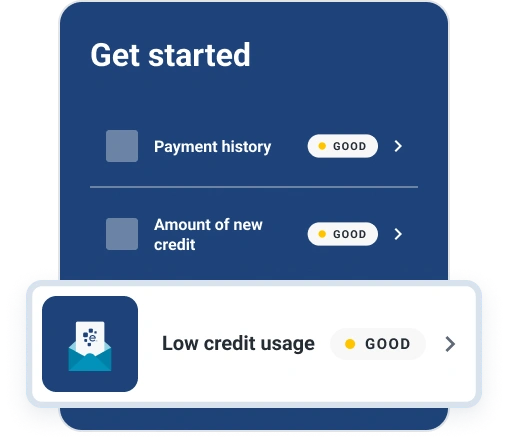At Experian, one of our priorities is consumer credit and finance education. This post may contain links and references to one or more of our partners, but we provide an objective view to help you make the best decisions. For more information, see our Editorial Policy.
In this article:
Your credit utilization ratio is a calculation of how the balances on your revolving credit accounts compare with your credit limits. Both your overall utilization ratio and the utilization ratio of individual accounts can affect your credit scores. Understanding exactly how utilization is calculated, which accounts are included and how to lower your utilization can be important for getting and maintaining an excellent score.
What Is Credit Utilization?
Your credit utilization ratio is the percentage of available credit that you're using on revolving credit accounts, such as credit cards. We'll go into more specifics about which accounts are included and how to calculate utilization, but here are a few important points to keep in mind:
- Utilization is the percent of your available revolving credit that you're using.
- Utilization calculations are based on the information in your credit report, not an account's current balances.
- Lower utilization ratios are best for your credit scores.
Utilization ratios are part of the "amounts owed" category for FICO® Scores☉ , which can make up approximately 30% of your score. The category also includes other factors, such as how many of your credit accounts have balances and the amount you owe on different types of credit accounts, such as loans. But generally, credit utilization is a key component in the amounts owed category.
Which Accounts Factor Into Credit Utilization?
Credit utilization is solely for revolving credit accounts, which can include:
- Credit cards
- Personal lines of credit
- Home equity lines of credit
There are some differences depending on the specific type of credit score. For example, VantageScore credit scores don't include closed accounts in utilization calculations, while your FICO® Score might include closed accounts if they still have a balance. Additionally, some versions of the FICO® Score exclude home equity lines of credit from credit utilization calculations.
Installment loans, including personal loans, student loans, mortgages and auto loans, are never part of credit utilization. The amount you owe on the accounts relative to the initial loan amount and how many accounts you have with balances can affect your credit scores—but not your credit utilization.
How to Calculate Your Credit Utilization Rate
Most credit scores calculate credit utilization using the balance your credit card issuer most recently reported to the credit bureaus and the credit limit reflected on your credit report. And some newer credit scoring models also look at trended data, such as your credit utilization over time. In either case, these numbers come from your credit report, which likely won't reflect your current balance if you regularly use your credit cards.
The calculations are simple, as you only need to use basic division and multiplication to find the utilization ratio on a single account.
Calculating Individual Revolving Account Utilization
To find the utilization ratio on a single card, you'll look for the card in your credit report and find its balance and credit limit. For example, if your credit report shows the credit card has a $1,000 balance and a $5,000 credit limit, your utilization ratio is 20%. To break that down:
- Find the card in your credit report and identify the account's most recently reported balance ($1,000) and credit limit ($5,000).
- Divide 1,000 by 5,000 to get 0.2.
- Multiply the 0.2 by 100 to get a percent (20%), rounding to the nearest whole number.
Calculating Overall Revolving Credit Utilization
Finding your overall utilization isn't much more complicated. Again, review a current copy of your credit report and then:
- Add the account balances and credit limits from all revolving credit accounts.
- Divided the sum of the balances by the sum of the credit limits.
- Multiply the result by 100 and round to the nearest whole number to find the percentage.
How to Reduce Your Credit Utilization Rate
You may be able to improve your credit score if you lower your overall utilization ratio and the utilization ratio of individual accounts.
You can aim to keep your overall ratio under 30% as a general rule of thumb, but under 10% could be even better for your scores. The highest utilization ratio on a single account could also be a factor. So, even if you have a low overall utilization ratio, maxing out one card could hurt your credit score.
With all this in mind, here are a few things you could do to try to lower your utilization:
- Make fewer credit card purchases. Shifting some of your spending away from credit cards could help you lower your credit card balances and the resulting utilization.
- Make early credit card payments. Credit card issuers tend to report your card's balance around the end of each billing cycle. You can make early payments to lower your balance before it's reported, leading to a lower balance on your credit report.
- Increase credit card limits. You might be able to get a credit limit increase if you ask your card issuer, especially if your income or credit score have increased since you first opened your card.
- Apply for new credit cards. Opening new credit accounts solely to increase your overall available credit might not be a good idea, and new accounts can hurt your credit scores in other ways. If you do get a new credit card, the additional credit could help lower your utilization.
Compare top credit cards matched for you
You also might not want to close credit cards or lines of credit, even if you don't frequently use them, to maintain a higher amount of overall available credit. Although, you might want to close cards that have an annual fee—or ask the card issuer if you can switch to a no-fee card and keep your account open.
Get a Free Experian Credit Report With Your Utilization Calculations
Rather than having to do the calculations on your own, your credit report might include your overall and individual credit utilization ratios. However, the names will sometimes be different, such as credit usage or debt-to-credit ratio instead of utilization ratio.
For example, if you get a free credit report from Experian, you'll see your overall utilization ratio as part of the overview. Then, click on individual revolving accounts to see more details about the account, such as its utilization ratio and payment history.




